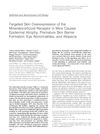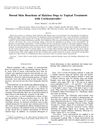Search
forLearn
4 / 4 resultslearn Low Level Laser Therapy
laser therapy for anti-inflammatory and likely insignificant hair regrowth effects
learn Osteopontin
signaling protein that, when suppressed, may grow hair by reducing inflammation and stem cell loss
learn Thymosin Beta 4
Research
5 / 1000+ results
research Targeted Skin Overexpression of the Mineralocorticoid Receptor in Mice Causes Epidermal Atrophy, Premature Skin Barrier Formation, Eye Abnormalities, and Alopecia
Overexpressing the mineralocorticoid receptor in mouse skin causes skin thinning, early skin barrier development, eye issues, and hair loss.
research Faculty Opinions Recommendation of Targeted Skin Overexpression of the Mineralocorticoid Receptor in Mice Causes Epidermal Atrophy, Premature Skin Barrier Formation, Eye Abnormalities, and Alopecia
Overexpression of a specific receptor in mice skin causes skin thinning, early skin barrier formation, eye issues, and hair loss.
research Cutaneous Lesions in Rats Following Administration of an Irreversible Inhibitor of ErbB Receptors, Including the Epidermal Growth Factor Receptor
CI-1033 causes skin lesions in rats, similar to humans, due to EGF receptor inhibition.
research The Effect of Zinc Sulfate in the Prevention of Radiation-Induced Dermatitis
Zinc sulphate may help reduce skin damage from radiation therapy.

research Dorsal Skin Reactions of Hairless Dogs to Topical Treatment with Corticosteroids
Stronger corticosteroids cause more skin damage in hairless dogs, similar to effects in humans.
Community Join
5 / 83 resultscommunity Topical finasteride has affected my hormones
A 21-year-old experienced hormone changes after using self-made topical finasteride for hair loss, including a 20% decrease in DHT, a 47% increase in testosterone, and a 39% increase in estradiol. The user previously used minoxidil and microneedling but is now seeking ways to balance hormones, possibly through supplements or dosage adjustments.

community Compressed part of research of theory of androgenic/anabolitic balance. AGA h-responders analytic. Theory of physio-metabolitic method of anti AGA treatment
The treatment for androgenetic alopecia involves using finasteride and minoxidil with intense exercise and cold exposure to boost metabolism and reduce androgenic effects, potentially leading to hair regrowth. This approach may activate biological pathways for improved hair and overall health.
community New Treatments, and a Huge Group Buy with Lots of Research
A user is organizing a group buy for various compounds aimed at reversing hair loss and gray hair, and improving brain health and fat loss. The user has developed a treatment plan based on extensive research and is inviting others to participate, with the option to choose only the compounds they need.
community Regrowing my hair/line without Min or Fin September (update) mechanical stimulation
The user regrew their hairline using mechanical stimulation, including a 1.5mm derma roller weekly, daily scalp massages, and other treatments like Nizoral, zinc pyrithione, fish oil, and Lipogaine The Big 5. They did not use Minoxidil or finasteride.
community Clearing the air on how non-surgical treatments really work
Treatments for hair loss, including finasteride, dutasteride, minoxidil, ketoconazole, microneedling, and low level laser light therapy, which aim to reduce DHT production, increase cell absorption and blood flow, and stimulate epidermal stem cells. It also stresses the importance of patience when using these treatments.